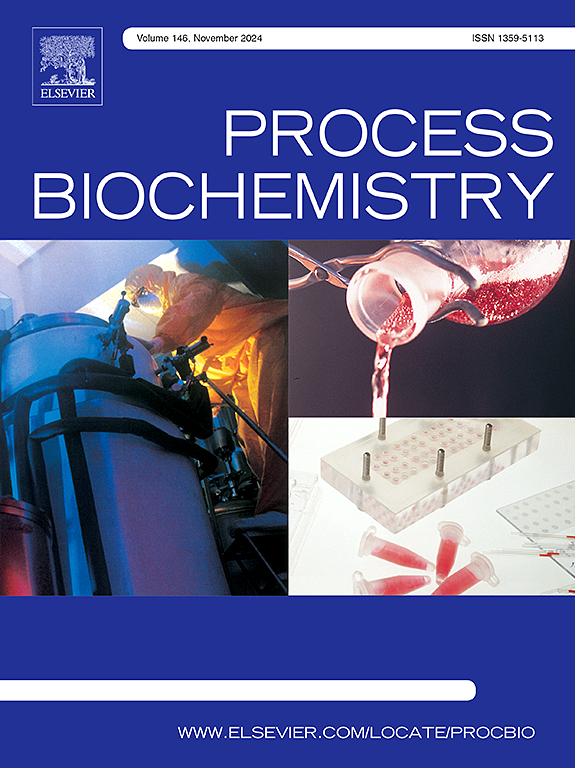以酿酒酵母和马氏酵母生产乙醇为培养基的灭菌生龙舌兰酒asse:动力学参数的估计和比较
IF 4
3区 生物学
Q2 BIOCHEMISTRY & MOLECULAR BIOLOGY
引用次数: 0
摘要
龙舌兰酒生产过程中产生的酒糟作为废水,可以用来生产乙醇。为了评估酒糟在循环生物经济中作为生物燃料来源的价值,以葡萄糖为模型底物和两种传统酵母配制了灭菌和未经加工的酒糟培养基,进行比较。其中一种是酿酒葡萄球菌,另一种是马氏葡萄球菌,是从龙舌兰酒的酒液中分离出来的。结果表明,在灭菌的酒液中,两种酵母都激活了次生代谢途径,作为对抑制化合物和盐的应激反应,其中酿酒酵母表现出更好的乙醇产量(1.3 g L−1 h−1)。然而,当采用ALE策略提高马氏酵母对酒糟应激源的耐受性时,则相反。与酿酒酵母(1.1 g L−1 h−1)相比,改良K. marxianus在原料酒液中提高了乙醇产量(1.2 g L−1 h−1)。为了量化培养基和菌株对乙醇生产的影响,建立了一个动态数学模型,并对每种情况下的参数值进行了拟合。数值比较表明ALE策略能够满足对介质的反应速率,与实验数据一致。当考虑Monod反应速率时,ALE后最大反应速率和半速度常数均增加;因此,导致反应更快,反应速率在较大的底物浓度下达到饱和。反过来,两种酵母的参数值彼此相似。这些结果证实了龙舌兰酒糟培养基适合用于乙醇生产。本文章由计算机程序翻译,如有差异,请以英文原文为准。
Sterilized and raw tequila vinasse as a medium for ethanol production via S. cerevisiae and K. marxianus: Estimation and comparison of its kinetic parameters
Tequila production generates vinasse as wastewater that may be valorized to produce ethanol. To assess vinasse’s value as a source of biofuel in circular bioeconomy, culture media were formulated with sterilized and raw vinasse using glucose as model substrate and two conventional yeasts, for comparison. One of them is S. cerevisiae, and the other strain, K. marxianus, was isolated from a tequila vinasse. In sterilized vinasse, results suggest that both yeasts activate secondary metabolic pathways as stress response to inhibitory compounds and salt, being S. cerevisiae the strain that showed better ethanol production (1.3 g L−1 h−1). However, such a remark is opposite when K. marxianus was subjected to ALE strategy to improve its tolerance to vinasse’s stressors. Adapted K. marxianus enhanced its ethanol production (1.2 g L−1 h−1) as compared to S. cerevisiae (1.1 g L−1 h−1) in raw vinasse. To quantify how media and strains affect ethanol production, a dynamic mathematical model was formulated, and its parameter values were fitted for each scenario. A comparison of such values shows that ALE strategy adequates the reaction rate to the media, agreeing with experimental data. Both the maximum reaction rate and the half velocity constant increased after ALE, when considering a Monod reaction rate; thus, leading to a quicker reaction and to a reaction rate that saturates at larger substrate concentrations. In turn, the parameters values with both yeasts are similar to each other. These results confirm that tequila vinasse medium is suitable for ethanol production.
求助全文
通过发布文献求助,成功后即可免费获取论文全文。
去求助
来源期刊

Process Biochemistry
生物-工程:化工
CiteScore
8.30
自引率
4.50%
发文量
374
审稿时长
53 days
期刊介绍:
Process Biochemistry is an application-orientated research journal devoted to reporting advances with originality and novelty, in the science and technology of the processes involving bioactive molecules and living organisms. These processes concern the production of useful metabolites or materials, or the removal of toxic compounds using tools and methods of current biology and engineering. Its main areas of interest include novel bioprocesses and enabling technologies (such as nanobiotechnology, tissue engineering, directed evolution, metabolic engineering, systems biology, and synthetic biology) applicable in food (nutraceutical), healthcare (medical, pharmaceutical, cosmetic), energy (biofuels), environmental, and biorefinery industries and their underlying biological and engineering principles.
 求助内容:
求助内容: 应助结果提醒方式:
应助结果提醒方式:


